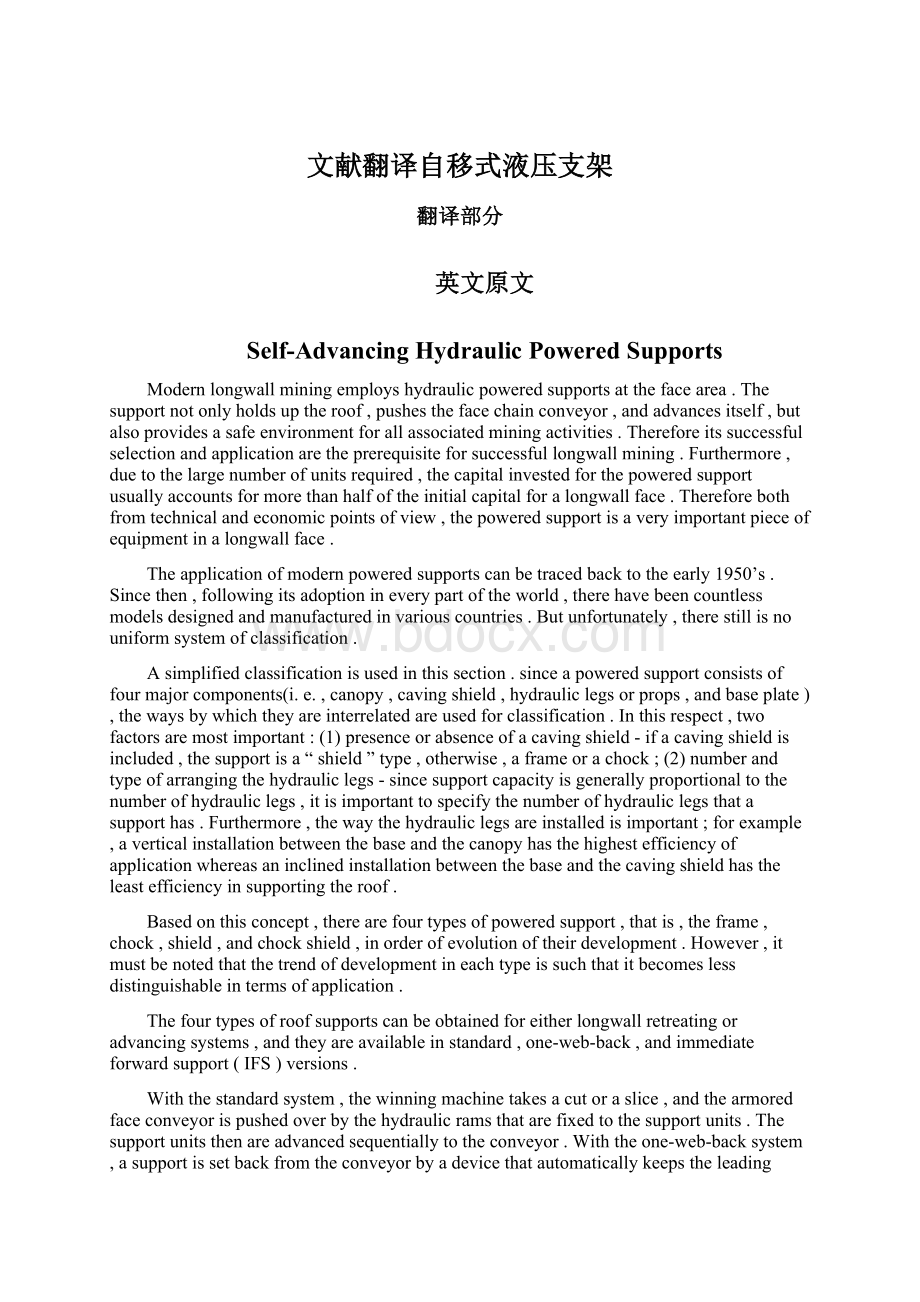文献翻译自移式液压支架Word格式文档下载.docx
《文献翻译自移式液压支架Word格式文档下载.docx》由会员分享,可在线阅读,更多相关《文献翻译自移式液压支架Word格式文档下载.docx(9页珍藏版)》请在冰豆网上搜索。

Self-AdvancingHydraulicPoweredSupports
Modernlongwallminingemployshydraulicpoweredsupportsatthefacearea.Thesupportnotonlyholdsuptheroof,pushesthefacechainconveyor,andadvancesitself,butalsoprovidesasafeenvironmentforallassociatedminingactivities.Thereforeitssuccessfulselectionandapplicationaretheprerequisiteforsuccessfullongwallmining.Furthermore,duetothelargenumberofunitsrequired,thecapitalinvestedforthepoweredsupportusuallyaccountsformorethanhalfoftheinitialcapitalforalongwallface.Thereforebothfromtechnicalandeconomicpointsofview,thepoweredsupportisaveryimportantpieceofequipmentinalongwallface.
Theapplicationofmodernpoweredsupportscanbetracedbacktotheearly1950’s.Sincethen,followingitsadoptionineverypartoftheworld,therehavebeencountlessmodelsdesignedandmanufacturedinvariouscountries.Butunfortunately,therestillisnouniformsystemofclassification.
Asimplifiedclassificationisusedinthissection.sinceapoweredsupportconsistsoffourmajorcomponents(i.e.,canopy,cavingshield,hydrauliclegsorprops,andbaseplate),thewaysbywhichtheyareinterrelatedareusedforclassification.Inthisrespect,twofactorsaremostimportant:
(1)presenceorabsenceofacavingshield-ifacavingshieldisincluded,thesupportisa“shield”type,otherwise,aframeorachock;
(2)numberandtypeofarrangingthehydrauliclegs-sincesupportcapacityisgenerallyproportionaltothenumberofhydrauliclegs,itisimportanttospecifythenumberofhydrauliclegsthatasupporthas.Furthermore,thewaythehydrauliclegsareinstalledisimportant;
forexample,averticalinstallationbetweenthebaseandthecanopyhasthehighestefficiencyofapplicationwhereasaninclinedinstallationbetweenthebaseandthecavingshieldhastheleastefficiencyinsupportingtheroof.
Basedonthisconcept,therearefourtypesofpoweredsupport,thatis,theframe,chock,shield,andchockshield,inorderofevolutionoftheirdevelopment.However,itmustbenotedthatthetrendofdevelopmentineachtypeissuchthatitbecomeslessdistinguishableintermsofapplication.
Thefourtypesofroofsupportscanbeobtainedforeitherlongwallretreatingoradvancingsystems,andtheyareavailableinstandard,one-web-back,andimmediateforwardsupport(IFS)versions.
Withthestandardsystem,thewinningmachinetakesacutoraslice,andthearmoredfaceconveyorispushedoverbythehydraulicramsthatarefixedtothesupportunits.Thesupportunitsthenareadvancedsequentiallytotheconveyor.Withtheone-web-backsystem,asupportissetbackfromtheconveyorbyadevicethatautomaticallykeepstheleadingedgeofthesupportatafixeddistancefromtheconveyor.Thisallowseasyaccessthroughthefaceandemploysthestandardmethodofadvancing;
i.e.,pushingtheconveyorfirst,andthenadvancingthesupport.
WiththeIFSsystem,thesupportunitisadvancedtotheconveyorimmediatelyafterthecuttingmachinehaspassed,andtheforwardcanopyofthesupportunitislongenoughtosupportboththerecentlyandnewlyexposedroofsections.Afterthesupportshavebeenadvanced,theconveyorispushedover.
FRAME
Theframesupportisanextensionofthesinglehydraulicpropsconventionallyusedunderground.Thusitisthefirsttypedevelopedinmodernself-advancinghydraulicpoweredsupports.Itinvolvessettinguptwohydraulicpropsorlegsverticallyintandemthatareconnectedatthetopbyasingleortwosegmentedcanopies.Thetwosegmentedcanopiescanbehinge-jointedatanypointbetweenthelegsorinfrontofthefrontleg.Thebaseofthetwohydrauliclegsmaybeacircularsteelshoeweldedatbottomofeachlegorasolidbaseconnectingbothlegs(Fig.8.8).
Generally,aframesupportconsistsoftwoorthreesetsofhydrauliclegs.Thesetmovingfirstisthesecondaryset,thesetmovinglateristheprimaryset.Thereisadouble-actingraminstalledbetweeneachset.Thepistonoftheramisconnectedtothesecondarysetandthecylindertotheprimaryset.Duringsupportadvance(Fig.8.9),theprimarysetissetagainsttheroofwhilethesecondarysetisloweredandpushedforwardbythepiston.Havingreachedthenewposition,thesecondarysetissetagainsttheroofwhiletheprimarysetisloweredandpulledforwardbythecylinder.Thedistanceofeachadvancerangesfrom20to36in.(0.50~0.91m).
Fig.8.8Framesupport
a-primarysetb-secondaryset
ABC
Fig.8.9Methodofadvancingtheframesupport
Theframesupportisverysimple,butmoreflexibleorlessstablestructurally.Thereareconsiderableuncoveredspacesbetweenthetwopiecesofcanopywhichallowsbrokenroofrocktofallthrough.Consequently,theframesupportisnotsuitableforaweakroof.Frameshavebecomeseldomusedbecausetheyarelessstableandrequirefrequentmaintenance.
CHOCK
Inachocksupport,thecanopyisasolidpieceandthebasemaybeeitherasolidpieceortwoseparatepartsconnectedbysteelbarsattherearand/orthefrontends.Inbothcasesalargeopenspaceisleftatthecenterforlocatingthedouble-actinghydraulicramwhichisusedtopushandpullthechainconveyorandthechockinawholeunit,respectively,adistinctivedifferencefromtheframesupport.Thissetupdesignedforthinseamswithtwolegsinthefrontandfourlegsintherear,separatedbyawalkwaisalsousedintheshieldsandchockshields.
Again,allhydrauliclegsareinstalledverticallybetweenthebaseandthecanopy(Fig.8.10).Thenumberoflegsrangesfromthreetosix,butthefour-legchocksarebyfarthemostpopularones.Thesix-legchocksarey(Fig.8.10c).Forthesix-legchocks,thecanopyisgenerallyhinge-jointedabovethewalkway.Mostchockarealsoequippedwithagobwindowhangingattherearendofthecanopy.Thegobwindowconsistsofseveralrectangularsteelplatesconnectedhorizontallyatbothends.
ABC
Fig.8.10Schematicsofvariouschocksupport
Inmostchocksupports,therearehingejointconnectionsbetweenthelegsandthecanopyandbetweenthelegsandthebase.Butinordertoincreasethelongitudinalstability,itisreinforcedmostlywithabox-shapedsteelframebetweenthebaseandeachleg.Alegrestoringdeviceisinstalledaroundeachlegatthetopofthebox-shapedsteelframe.
Thechocksaresuitableformediumtohardroof.Whentheroofoverhangswellintothegobandrequiresinducedcaving,thechockscanprovideaccesstothegob.
SHIELD
Shields,anewentryintheearlyseventies,arecharacterizedbytheadditionofacavingshieldattherearendbetweenthebaseandthecanopy.Thecavingshields,whichingeneralareinclined,arehinge-jointedtothecanopyandthebasemakingtheshieldakinematicallystablesupport,amajoradvantageovertheframesandthechocks.Italsocompletelysealsoffthegobandpreventsrockdebrisfromgettingintothefacesideofthesupport.Thustheshield-supportedfaceisgenerallyclean.
Thehydrauliclegsintheshieldsaregenerallyinclinedtoprovidemoreopenspacefortraffic.Becausethecanopy,cavingshield,andbaseareinterconnected,itcanwellresistthehorizontalforcewithoutbendingthelegs.Thus,unlikethesolidconstraintintheframe/chocksupports,thepinconnectionsbetweenthelegsandthecanopy,andbetweenthelegsandthebaseinashieldsupportmakeitpossiblethattheangleofinclinationofthehydrauliclegsvarieswiththeminingheights.Sinceonlytheverticalcomponentofhydrauliclegpressureisavailableforsupportingtheroof,theactualloadingcapacityoftheshieldalsovarieswiththeminingheights.
Therearemanyvariationsoftheshieldsupports.Inthefollowing,sixitemsareusedtoclassifytheshields,whichenablesaunifiedterminologytobedevelopedforallkindsofshields.Thetypesofmotionaltracesofthecanopytip,legpositionsandorientation,numberoflegs,canopygeometry,andotheroptionaldesignsanddevicescanbeclearlyspecifiedbytheterminology.
TYPESOFMOTIONALTRACESFORTHELEADINGEDGEOFTHECANOPY.
Thisisthemostcommonlyrecognizedwayofclassifyingtheshield.Basedonthiscriterion,therearethreetypes,lemniscate,caliper,andellipse(Fig.8.11).
A.Lemniscate.LB.Caliper.CC.Ellipse.E
Fig.8.11Threetypesofmotionaltracesforleadingedgeoftheshieldcanopy
A.Lemniscate.Thisisthemostpopulartype.Thecavingshieldandthebasearejointedbytwolemniscatebarswhichhaveatotaloffourhinges.Asthehydrauliclegsareraisedandlowered,thedimentionsofthelemniscatebarsareselectedsuchthattheleadingedgeofthecanopymovesupanddownnearlyvertically,thusmaintaininganearlyconstantunsupporteddistancebetweentheface-lineandtheleadingedgeofthecanopy.Thisisafeaturethatiswidelyconsideredmostdesirableforgoodroofcontrol.Thereareclearlimitsofminingheightwithinwhichtheleadingedgeofthecanopymovesnearlyvertically.Theselimitsarestrictlycontrolledbythedimentionalandpositionalarrangementsofthecanopy,cavingshield,lemniscatebars,andthebase.Beyondtheselimits,theedgeswillmoverapidlyawayfromtheface-linecreatingalargeunsupportedarea.
B.Caliper.Inacalipershield,thecavingshieldandthebaseareconnectedbyasinglehinge.Whenthehydrauliclegsareraised,theleadingedgeofthecanopymovesinanarcawayfromtheface,thusincreasingtheunsupportedareaThisisconsider